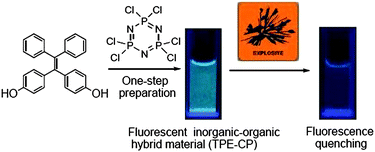One-step preparation of fluorescent inorganic–organic hybrid material used for explosive sensing†
Abstract
As a fluorescent inorganic–organic hybrid

* Corresponding authors
a
National Center for Nanoscience and Technology, Beijing, China
E-mail:
hanbh@nanoctr.cn
Fax: +86-10-82545576
b
College of Chemistry and Chemical Engineering, Graduate University of Chinese Academy of Sciences, Beijing, China
E-mail:
heyujian@gucas.ac.cn
c
Department of Chemistry, Beijing Institute of Technology, Beijing, China
E-mail:
jcao@bit.edu.cn
As a fluorescent inorganic–organic hybrid

 Please wait while we load your content...
Something went wrong. Try again?
Please wait while we load your content...
Something went wrong. Try again?
X. Hu, Q. Chen, D. Zhou, J. Cao, Y. He and B. Han, Polym. Chem., 2011, 2, 1124 DOI: 10.1039/C1PY00012H
To request permission to reproduce material from this article, please go to the Copyright Clearance Center request page.
If you are an author contributing to an RSC publication, you do not need to request permission provided correct acknowledgement is given.
If you are the author of this article, you do not need to request permission to reproduce figures and diagrams provided correct acknowledgement is given. If you want to reproduce the whole article in a third-party publication (excluding your thesis/dissertation for which permission is not required) please go to the Copyright Clearance Center request page.
Read more about how to correctly acknowledge RSC content.
 Fetching data from CrossRef.
Fetching data from CrossRef.
This may take some time to load.
Loading related content
